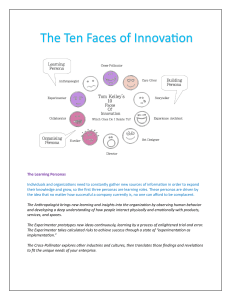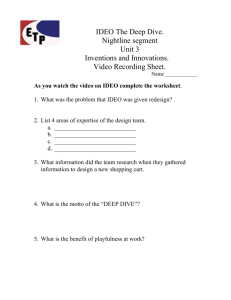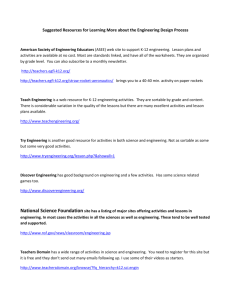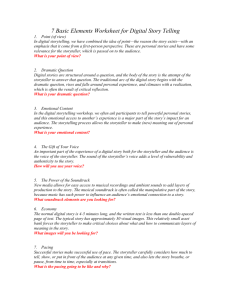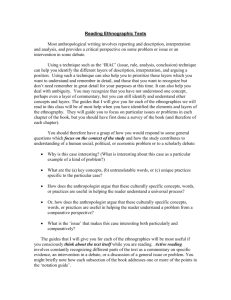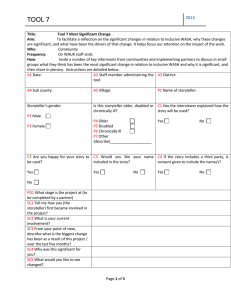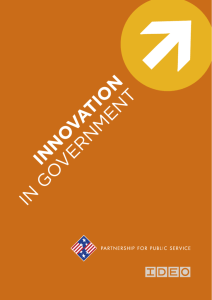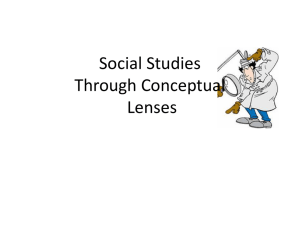Document
advertisement
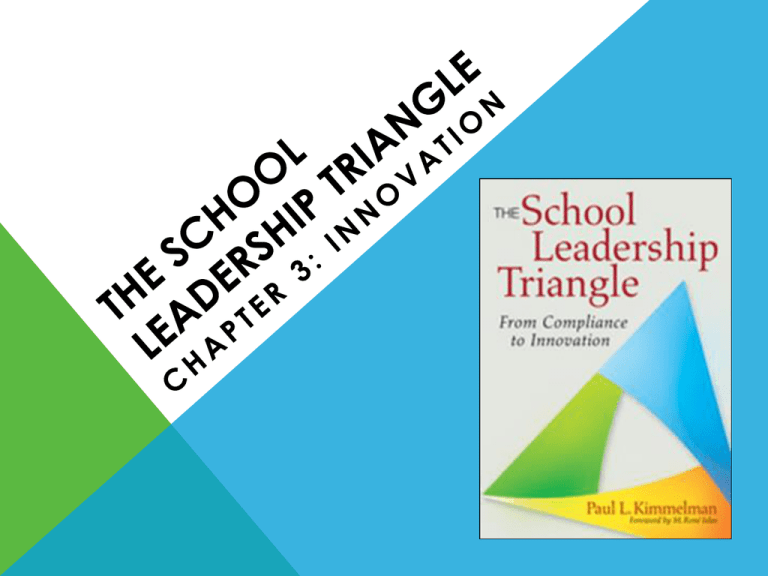
THE WORLD LEADERS IN INNOVATION AND CREATIVITY WILL ALSO BE WORLD LEADERS IN EVERYTHING ELSE. Harold R. McAlindon DEFINITION Innovation is the process of improving an existing product or service and not, as is commonly assumed, the introduction of something better . Encarta Encyclopedia The term derives from the Latin innovatus, past participle of innovare "to renew or change," from in- "into" + novus "new". Etymology Dictionary SO WHAT IS INNOVATION? IDEO’S INNOVATION PROCESS KELLEY’S TEN FACES OF INNOVATION 1. The Anthropologist 2. The Experimenter 3. The Cross-Pollinator 4. The Hurdler 5. The Collaborator 6. The Director 7. The Experience Architect 8. The Set Designer 9. The Storyteller 10. The Caregiver DOBLIN’S TEN TYPES OF INNOVATION 1. Business Model 2. Networking 3. Enabling process 4. Core process 5. Product performance 6. Product system 7. Service 8. Channel 9. Brand 10. Customer experience IDEO’S SEVEN RULES FOR BRAINSTORMING 1. Defer judgment 2. Encourage wild ideas 3. Build on the ideas of others 4. Stay focused on the topic 5. One conversation at a time 6. Be visual 7. Go for quantity LAFLEY & CAHRAN’S RULES FOR BRAINSTORMING 1. Get a facilitator. 2. Be prepared. 3. Relax. 4. Leaders should follow. 5. Get everyone to contribute. 6. Keep track of ideas. 7. Think ahead. 8. Use props. 9. Go outside the lines. 10. Follow the rules. TOYOTA’S TEN STEP INNOVATION PROCESS 1. Let learning lead. 2. Learn to See 3. Design for Today 4. Think in Pictures 5. Capture the Intangible. 6. Leverage the Limits 7. Master the Tension 8. Run the Numbers 9. Make Kaizen Mandatory 10. Keep it Lean LENCIONI’S FIVE DYSFUNCTIONS OF A TEAM 1. Absence of Trust 2. Fear of Conflict 3. Lack of Commitment 4. Avoidance of Accountability 5. Inattention to Results KIMMELMAN’S EDUCATION INNOVATION PROCESS FRAMEWORK Step 1: Identify and discuss the problem Step 2: Designate an innovation coach to lead the innovation team Step 3: Organize the innovation team and propose innovative ideas Step 4: Prioritize some of the proposed ideas Step 5: Develop and test prototypes Step 6: Conduct short-term formative evaluation Step 7: Revise the innovation plan PROMISING INNOVATIONS IN EDUCATION THE NEED FOR INNOVATION To align our educational system to the 21st century world, both simple and complex innovations are critical to improve teaching and learning. For such improvement to take place it is necessary for people to change the way they make decisions, and start thinking or making choices outside of their norm. OVERALL NEED CREATE AN INNOVATIVE CULTURE IN SCHOOLS [AND MC3] DISCUSSION ACTIVITY QUESTIONS 1. Identify the three most serious problems that you think need to be fixed in your school or district our center. Discuss why they are serious, how you ranked them as the top three, and what evidence/data you have to support 1. Defer judgment your selections. 2. Encourage wild ideas 3. Build on the ideas of others 4. Stay focused on the topic 5. One conversation at a time 6. Be visual 7. Go for quantity DISCUSSION ACTIVITY QUESTIONS 2. Hypothetically, select a diverse team of 10 people to work on one of the priorities you listed in Question 1. Why did you select these individuals? 1. The Anthropologist 2. The Experimenter 3. The Cross-Pollinator 4. The Hurdler 5. The Collaborator 6. The Director 7. The Experience Architect 8. The Set Designer 9. The Storyteller 10. The Caregiver DISCUSSION ACTIVITY QUESTIONS 3. Using one of the priorities you identified in Question 1 and the team you selected in Question 2, go through the innovation process framework in this chapter and informally practice each step. Step 1: Identify and discuss the problem Step 2: Designate an innovation coach to lead the innovation team Step 3: Organize the innovation team and propose innovative ideas Step 4: Prioritize some of the proposed ideas Step 5: Develop and test prototypes Step 6: Conduct short-term formative evaluation Step 7: Revise the innovation plan DISCUSSION ACTIVITY QUESTIONS 4. Design a prototype of your innovation idea to fix the problem. FINAL THOUGHTS?
